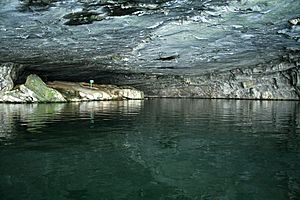Nickajack Cave facts for kids
Nickajack Cave is a very large cave in Marion County, Tennessee. Part of it is filled with water. This happened when the Tennessee Valley Authority built Nickajack Dam in 1967, creating Nickajack Lake.
The cave's entrance was once 140 feet wide and 50 feet high. Now, about 25–30 feet of water covers the bottom part. So, the opening above the water is still 140 feet wide but only 20–25 feet high. Nickajack Cave is home to a huge group of Gray Bats. These bats are an endangered species. The higher water levels have sometimes put the bat colony in danger.
The cave got its name from the Chickamauga Cherokee town of Nickajack. This town was located near the cave's mouth and the Tennessee River. In 1794, the town was attacked and destroyed during an event called the Nickajack Expedition.
Contents
A Look into Nickajack Cave's Past
Nickajack Cave has a long and interesting history. People have used it for different purposes over many years.
Mining for Gunpowder
Mining for a substance called saltpeter began in Nickajack Cave in 1800. Saltpeter is a key ingredient used to make gunpowder. At this time, the Cherokee people owned the land where the cave was. They gave permission for the mining to happen.
This mining continued through the War of 1812. Later, during the American Civil War, the cave was mined for saltpeter again. This time, the Confederate government's Nitre and Mining Bureau ran the operation. Nickajack Cave was one of the biggest saltpeter caves used by the Confederates. This made it a very important place for them. Losing control of Nickajack Cave was a serious problem for the Confederacy.
Tours and Visitors
Nickajack Cave was open for tours at different times, starting around 1872. Back then, visitors could take a boat from Chattanooga to the cave. Guides would then take them inside the cave in boats. After the tour, visitors could catch a train back to Chattanooga.
In 1927, a man named Lawrence S. Ashley ran the cave tours. He supposedly disappeared in the cave while exploring. His disappearance was reported in newspapers. After being "lost" for a week, Ashley reappeared. He claimed he dug his way out through a new entrance miles away. It turned out this whole story was a trick. Ashley wanted to get more people to visit the cave.
By the 1940s, Leo Lambert managed the cave. He also developed another famous attraction nearby called Ruby Falls. During this time, the cave was sometimes called "Nickajack LaCaverns." The cave stopped being a public tourist attraction in the late 1940s.
Wildlife and Nature at Nickajack Cave
Today, Nickajack Cave is a special place for nature and animals. It is now a Wildlife Refuge. The Tennessee Wildlife Resources Agency manages it.
Unique Species Lost
When the cave was flooded in 1967, some unique animals that lived only in Nickajack Cave were lost. These included a type of crustacean called Caecidotea nickajackensis, a tiny spider-like creature called a pseudoscorpion (Microcreagris nickajackensis), and a ground beetle (Pseudanophthalmus nickajackensis). These creatures could not survive the flooding.
A Home for Bats
Nickajack Cave is a very important home for bats. It has a large colony of over 100,000 bats. The cave is a "maternity roost." This means that pregnant female gray bats come here every spring. They give birth and raise their young inside the cave.
There is a special viewing platform near the cave's entrance. Visitors can stand there at dusk to watch the bats fly out of the cave. They leave to go find food.
How to Visit the Cave
To find Nickajack Cave, travel west from Chattanooga on Interstate 24. Take exit 161 and turn left onto Highway 156 or Shellmound Road. Go about 4.8 miles. You will pass Macedonia Road and a small lake. The cave is located near this small lake. Turn left after passing the lake. You will see a sign for Nickajack Cave. There is a parking area for a boat ramp. At the back of the parking area, you will find a boardwalk. This boardwalk is about 1000 yards long and leads to the bat viewing platform.
Images for kids



